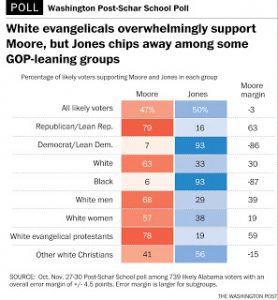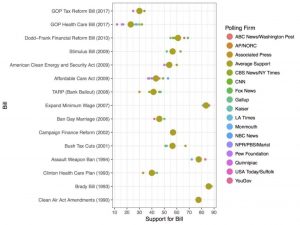The following article by Jack Metzgar is cross-posted from Working-Class Perspectives:
Politico’s Michael Kruse visited my hometown earlier this month to get a look at “one of the long-forgotten, woebegone spots in the middle of the country that gave Trump his unexpected victory last fall.” Kruse concluded that “Johnstown Never Believed Trump Would Help. They Still Love Him Anyway.” The story, based on interviews with nine Trump supporters and one man who voted for Hillary Clinton, is part of a stream of articles attempting to explain why Trumpians have remained so loyal to a president who has failed to deliver on any of his campaign promises so far and, for the most part, hasn’t even tried. Problem is that about the same time as this spate of articles appeared a well-respected poll showed “Most White Workers Souring on Trump.”
This sounds like a potentially important debate, but it never really becomes important because there is such a confusion of categories, often made worse by a lingering white-trash class prejudice that is sometimes used to resolve the confusion. Different authors are simply looking at different parts of an elephant while thinking they’re seeing the whole thing.
Kruse, for example, is focused on “Trump supporters,” who are often referred to as “Trump’s base” and who appear to be sticking with him come hell or high water. References to “Trump’s base” usually refer to “working-class whites,” who are white people without bachelor’s degrees and are generally thought to be a reservoir of racist, sexist, and other deplorable attitudes. But this class language confuses more than it clarifies. Whites without bachelor’s degrees voted overwhelmingly for Trump, and they are by far the largest group of Trump voters. But whites with bachelor’s degrees also narrowly voted for Trump over Clinton. Only 48% of Trump voters were working-class whites, while 38% were middle-class whites (by education), and 13% were nonwhite.
“Trump supporters” or “Trump’s base” are somewhat smaller groups than “Trump voters,” many of whom voted against Hillary rather than for Trump. But the larger point is that whether voters or supporters, Trumpians are not all whites without bachelor’s degrees – only about one-half of them are. The identification of Trump with the white working-class is mostly not true.
When Michael Kruse searched out nine people to represent all of Johnstown, he found one retail worker, one retired nurse, two retired teachers, three small business owners, the Johnstown city manager, and a man who would not identify his occupation. Kruse pays no attention to who does and does not have a bachelor’s degree. He very sensibly highlights their occupations, not their formal education. That means that Kruse’s interviewees are much more likely to reflect the complex class make-up of Trump’s base than the convenient belief that only un-college-educated white people would fall for a carnival-barker snake-oil salesman like Trump. In fact, more than 24 million white people with college educations voted for the guy.
While most reports on votes or polling define the working-class by lack of a college education, others define the working class by income (usually households with annual incomes below $50,000). But that definition of class also doesn’t support the idea that Trump won because of the white working class. Whites from households earning less than $50,000 are less likely to vote than other whites, and in 2016 those who did vote did not lopsidedly opt for Trump.
While education, occupation, and income are all reasonable ways to define a person’s social class, each describes a somewhat different group whose voting behavior is significantly different — despite overlap among these three categories. This generates constant confusion as different commentators make what seem like contradictory claims about the white working class when they are actually focused on somewhat different white working classes.
This is a legitimate intellectual confusion, especially common among well-educated journalists whose higher educations included little or nothing about class in America. Less legitimate, and much more false, is the growing willingness of political writers to use an educated/uneducated class binary among whites to distinguish between Trump voters in suburbs whose basic sense of decency can be appealed to and the Trump base which is seen as a hopelessly ignorant stew of economic nationalists who pine not just for lost jobs and economic prospects, but also for the good old days of patriarchy and white supremacy. The latter group definitely exists and, as Kruse demonstrates, it is not hard to find examples in places like my hometown, but the educated/uneducated binary does not hold, as at least half of Kruse’s sample likely have bachelor’s degrees and some of the weirdest attachments to the man with orange hair seem to reside in white business owners, not workers.
But there are two other problems with contrasting Trump voters from suburbs to Trump supporters from “woebegone spots in the middle of the country” as if they represented a simple educated/uneducated class binary. First, about two-thirds of adults who live in suburbs do not have bachelor’s degrees, and therefore, would be classified as working class. The suburban vote in large metropolitan areas is not synonymous with an educated white middle class – and hasn’t been for decades. Second, and even more elementary, just because you can easily find Trump supporters in woebegone spots doesn’t mean that all white folks in those spots are Trump supporters, as Kruse’s reporting so strongly implies.
Johnstown offers much more interesting fodder for political analysis than its woebegone-ness. It is in a swing county that in the 21st century has swung from Al Gore to George W. Bush to Barack Obama to Mitt Romney and finally to Trump last year. As British reporter Gary Younge found in his visit to Johnstown, economic desperation and every kind of decline you can think of accounts for both the area’s swingy-ness and its large number of Trump voters in 2016. Combining my own impressions with this county-wide voting data, here’s how I’d characterize Cambria County’s citizens:
The largest group among the white working class are non-voters, who either don’t care about politics at all or are disdainful of politicians of all stripes. They simply believe voting makes no difference. This group is itself complex, ranging from people who keep up with the news and have independent-minded opinions about issues to people who never watch or read much news at all and do not form opinions of their own about current issues. Among regular voters, there are strong Democrats and strong Republicans, somewhat skewed by race and class, but both groups include people with and without bachelor’s degrees.
But most importantly, Johnstown has swing voters, a group that has been growing larger as conditions in their communities and their lives continue to deteriorate. This group, along with the Democrats, voted for Obama in 2008, and a sizeable part of it voted for him again in 2012. But when Donald Trump came to Johnstown and promised to bring back coal mining and steel jobs, there was an enormous swing toward him in 2016. Given what President Obama had produced – a steady, substantial, but exceedingly slow economic recovery during which their already diminished lives either did not change or got worse – and what Hillary Clinton was half-heartedly promising, the Cambria County swing to Trump had a what-the-hell quality to it that was neither pathological nor irrational. As a former steelworker who voted for both Obama (twice) and Trump told Gary Younge, “I liked [Obama’s] message of hope, but he didn’t bring any jobs in.”
Trump tapped into a large well of hateful resentments that were simmering in Johnstown before he showed up, resentments that so far as I can tell are no more common in the white working class than in the white middle class. But if you focus on the swing voters, not the Trump zealots, you have to ask yourself what might swing these voters back to a more progressive politics. I suspect these alternative focuses are applicable across the Rust Belt states.
And this is part of the problem with the way reporters and other analysts focus on the Trump zealots as if they are the whole of the white working-class: they encourage Democrat politicians to aim to win over what they imagine as “traditional Republicans” in “affluent suburbs” – folks they hope will be increasingly disgusted by the character and behavior of our president. That approach may yield some votes. But this merely anti-Trump focus allows Dems to avoid hammering out a governing vision, message, and program that could really make a difference to voters like many in Johnstown – those who are desperately swinging back and forth in the vain hope that voting in the world’s oldest democracy might make a difference in the lives they get to live.





